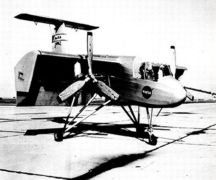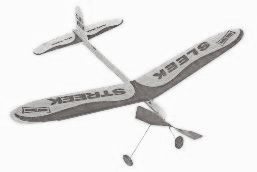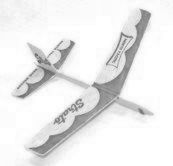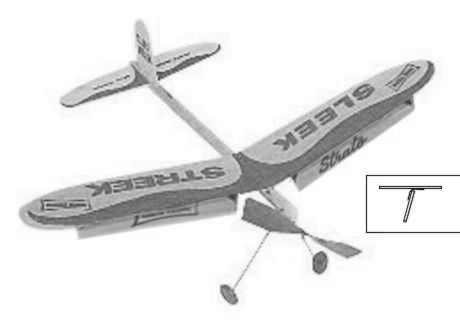THE VERTIPLANE
A Working Model of the Ryan Vertiplane
Constructed by the Page Author at Age 10

Ryan Vertiplane
In September 1960, Popular Science Magazine published a report about 8 different kinds of
vertical-take-off airplanes being developed.
Airliners That Take Off from a Parking Lot Popular Science Sep 1960 pp78-81
Most of these designs tilted the wing, tilted the engines (e.g. the Osprey), or diverted
the blast of a jet engine (e.g. The Harrier Jump Jet). Three of them had very unusual
designs. The Ryan Vertijet took off pointing straight up (like a rocket). The Flying Jeep
looked more like a hovercraft (and was probably just as unstable as the AvroCar (The USAF
attempt at a flying saucer) was at altitudes above 10 feet.
The third was the Ryan Vertiplane (see photo at right). It looked and behaved much like
an airplane, with one exception. It had the largest wing flaps ever seen (in proportion to
the wing size). Notice also how the propeller engines are set below the wing, so most of
the air coming from the propellers hits the flaps. This provides the lift needed to raise
the Vertiplane off the ground. The remaining air from the propeller goes over and behind
the wing. Some of it flows over the tail control surfaces so they still work. Raising the
flaps made the Vertiplane act as an ordinary airplane.
The Vertiplane was never put into production due to instability problems and low fuel
efficiency. The instability problems came from trying to balance the plane by varying
pitch of the two propellers, and what happened if one engine quit or developed power
problems. It could not land vertically with only one engine, and an engine failure on
takeoff caused a crash. They later linked the two propeller shafts to try to fix this.

Sleek Streek

Strato
In 1961, the page author amassed quite a collection of small balsa toy airplanes, the
products of North Pacific, Guillow's, American Junior, American Toy, and Testor's. They
ranged in price from 5 cents for the smallest to 89 cents for the most elaborate (in 1961
dollars). The page author had several copies of the same airplanes, so he could experiment
with unusual arrangements of the parts.
He had at least 3 copies of the North Pacific Sleek Streek "Rise off Ground"
propeller plane (upper photo at right), 6 copies of the North Pacific Strato glider
(5 cents, lower photo at right), 2 copies of the Guillow's Starfire glider, and 2 copies
of the Guillow's Sky Streak propeller plane. The North Pacific planes had plastic clips
that held the wings in place on top of the stick fuselage with a dihedral angle. The
Guillow's planes had a slot in a vertically thicker fuselage for the wing to slide into.
Among his successful creations made from rearranged parts were:
- reversed swept wing planes (Strato with wings on backwards)
- dragonfly planes (Strato with two tandem sets of wings)
- biplanes (Strato with a normal set of wings and another set of wings clipped on the
bottom)
- dual fuselage planes (like P-38, 2 Guillow's fuselages on 1 wing and stabilizer)
- canard designs (Strato wing set near tail behind 2 fins in second wing clip)
- missiles (no wing or a stabilizer instead of a wing)
- 3-fin missiles (Strato no wing, fin, and two fins in a wing clip on bottom of tail)
- A version of the X-15 (Guillow's with 2 stabilizers and a slot cut with an X-acto on
the bottom for an extra fin)
The page author was also a voracious reader, and read all of the issues of Popular
Science his father had. They wrote articles on how things work and how to do things back
then (the magazine today promotes things that are new with no technical explanations).

My flying model
When the page author found the article above, he had to try the Vertiplane. As seen in the
inset he fastened the wings from a North Pacific Strato to the bottoms of the wings of a
North Pacific Sleek Streek. Originally he used Scotch tape to attach the Strato wings to
the wing bottoms. The inset shows the arrangement - the front of the plane is to the right
in the inset.
The original experiment was made in a basement because of winter weather. Another
unmodified Sleek Streek was used for comparison:
- The unmodified Sleek Streek rose about 3 feet off the floor and flew the entire length
of the basement, hitting the wall.
- The Vertiplane model as originally constructed rose up about 4 feet and flew about half
the length of the basement at a slower speed.
- A second rubber band was added to increase the power. The results were astonishing to
even a 10-year-old. The Vertiplane model moved forward about half a foot, and then jumped
up about 5-6 feet into the air. It then increased forward speed to almost that of the
unmodified plane. It flew about 3/4 the length of the basement. When the plane slowed down,
it descended diagonally downward and soft landed on its wheels.
- Repeated observations showed that the flaps were folding back against the wings during
the horizontal flight and lowering again during the landing. The flight behavior was
consistent from flight to flight.
- Later experiments outside on a smooth paved driveway showed that a strong crosswind
could tip the Vertiplane model over during takeoff so that it landed upside down
(unharmed).
The page author kept this version, replacing the Scotch tape with paper hinges held in
place with Elmer's Glue. The inset shows how they were attached. He had it until his family
moved when he was 13. The plane was destroyed in the move.
The photo at right is a composite the page author made from the two photos above it. No
photos were ever taken of the original because of the relative expense of photography back
then. The original black and white photos were provided by balsaplanefan2. This article is
presented so others can try it.
Links:
- MY INVENTIONS AND DISCOVERIES



